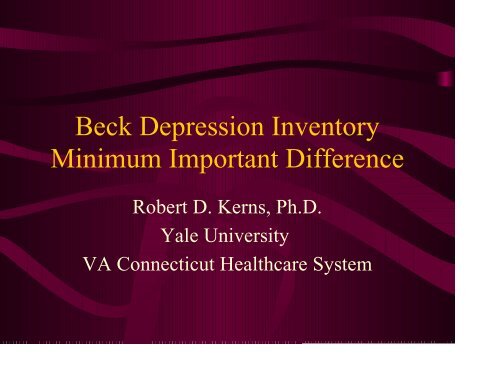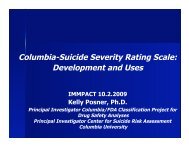Beck Depression Inventory - immpact
Beck Depression Inventory - immpact
Beck Depression Inventory - immpact
Create successful ePaper yourself
Turn your PDF publications into a flip-book with our unique Google optimized e-Paper software.
<strong>Beck</strong> <strong>Depression</strong> <strong>Inventory</strong><br />
Minimum Important Difference<br />
Robert D. Kerns, Ph.D.<br />
Yale University<br />
VA Connecticut Healthcare System
<strong>Beck</strong> <strong>Depression</strong> <strong>Inventory</strong><br />
<strong>Beck</strong>, A.T., Ward, C.H., Mendelson, M., Mock, J., &<br />
Erbaugh, J. (1961). An inventory for<br />
measuring depression. Archives of General<br />
Psychiatry, 4, 561- 571.<br />
<strong>Beck</strong>, A.T., Rush, A.J., Shaw, B.F., & Emery, G.<br />
(1979). Cognitive therapy for depression.<br />
New York: Guilford Press.<br />
<strong>Beck</strong>, A.T. & Steer, R.A. (1993). <strong>Beck</strong> <strong>Depression</strong><br />
<strong>Inventory</strong>. San Antonio, TX: Psychological<br />
Corporation.
<strong>Beck</strong> <strong>Depression</strong> <strong>Inventory</strong>:<br />
Psychometric reviews<br />
• <strong>Beck</strong>, A.T., Steer R.A., & Garbin, M.G. (1988).<br />
Psychometric properties of the <strong>Beck</strong> <strong>Depression</strong> <strong>Inventory</strong>:<br />
Twenty-five years of evaluation. Clinical Psychology<br />
Review, 8, 77-100.<br />
• Moran, P.W. & Lambert, M.J. (1983). A review of current<br />
assessment tools for monitoring changes in depression.<br />
In M.D. Lamber, E.R. Christiensen and S.S. Dejolie<br />
(Eds.), The assessment of psychotherapy and outcomes.<br />
New York: Wiley.<br />
• Yonkers, K.A. & Samson, J. (2000). Mood disorders<br />
measures. In American Psychiatric Association,<br />
Handbook of Psychiatric Measures. Washington, DC:<br />
American Psychiatric Association.
BDI:<br />
Symptoms and attitudes<br />
• Mood<br />
• Pessimism<br />
• Sense of failure<br />
• Lack of satisfaction<br />
• Guilt feelings<br />
• Sense of punishment<br />
• Self-dislike<br />
• Self-accusation<br />
• Suicidal wishes<br />
• Crying<br />
• Irritability<br />
• Social withdrawal<br />
• Indecisiveness<br />
• Distortion of body image<br />
• Work inhibition<br />
• Sleep disturbance<br />
• Fatigability<br />
• Loss of appetite<br />
• Weight loss<br />
• Somatic preoccupation<br />
• Loss of libido
BDI:<br />
Review from IMMPACT II<br />
• Designed to measure the behavioral<br />
manifestations of depression in adolescents<br />
and adults<br />
• Current version includes 21 groups of four<br />
statements relating to symptoms of depressive<br />
disorder<br />
• Respondents report how they are feeling “right<br />
now”<br />
• Responses in each cluster are scored numerically<br />
with a 0 to 3 representing level of severity;<br />
range for measure is 0-63
BDI:<br />
Review from IMMPACT II<br />
• Indices of internal consistency range from<br />
0.73 to 0.95<br />
• Stability indices range from 0.80 to 0.90<br />
• Validity estimates average around 0.60 for<br />
nonpsychiatric patients<br />
• Responsive to change during psychotherapy<br />
and medication trials; including relatively large<br />
number of pain intervention trials
BDI:<br />
Review from IMMPACT II<br />
• Strengths<br />
– Excellent psychometrics<br />
– Subject of extensive research in the pain field<br />
– Responsive to change in pain intervention research<br />
• Weaknesses<br />
– Not designed for use among persons with pain<br />
– Challenges regarding relevance of somatic symptoms and potential<br />
inflation of depressive symptom severity among persons<br />
with pain
BDI:<br />
Additional information<br />
• Numerous translations; reviews available<br />
for Spanish and German versions<br />
• Usually takes 5-10 minutes to complete<br />
• Fifth or sixth grade reading level
What are the implications of<br />
normative data on the BDI from<br />
other populations?
Normative data from psychiatric<br />
or substance abusing populations<br />
Mixed diagnostic (n=248): 38.27 (12.98)<br />
MDD/Single epi.(n=113): 38.52 (13.98)<br />
MDD/Recurrent (n=168): 37.21 (12.51)<br />
Dysthymic (n=99): 36.15 (11.07)<br />
Alcoholic (n=105): 37.99 (9.97)<br />
Heroin (n=211): 27.65 (5.81)
BDI:<br />
Recommended cut-offs<br />
None to minimal depression:
BDI:<br />
Recommended cut-offs<br />
These cut-off scores are derived from<br />
analyses of mean BDI scores for persons<br />
classified in categories of depression based<br />
on clinical ratings:<br />
– Minimal: 10.9 (8.1)<br />
– Mild: 18.7 (10.2)<br />
– Moderate: 25.4 (9.6)<br />
– Severe: 30.0 (10.4)
Implications for determining a<br />
minimally important difference<br />
in pain outcome studies<br />
Recommendation 1: Improvement is judged to be<br />
present when an individual reports a BDI score in<br />
the “normal” range (I.e., below 10) following<br />
treatment<br />
Recommendation 2: Improvement is judged to be<br />
present when a person’s post-treatment score falls<br />
into a lower category of depression severity (I.e., a<br />
change from the moderate to the mild category)
Implications for determining a<br />
minimally important difference<br />
in pain outcome studies<br />
Recommendation 3:<br />
– Principle: A minimally important difference is judged<br />
to be ½ standard deviation of the population mean<br />
– Observation: The standard deviation for each category<br />
of depression severity ranges from 8.1 to 10.4<br />
– Specific recommendation based on normative data: A<br />
change of 5 on the BDI is judged to be a minimally<br />
important difference
What useful information can be<br />
derived from pain-relevant<br />
studies?
Geisser et al. (1997)<br />
132 consecutive patients with chronic pain; 44<br />
had MDD according to DSM-IV<br />
Discriminant function analysis suggested a<br />
cut-off score on the BDI of 21 for<br />
MDD; correctly classified 75% of<br />
sample (68.2% sensitivity, 72.7%<br />
specificity, PPV = 61.2%, NPV =<br />
83.1%)<br />
Non-depressed Depressed<br />
BDI Total 14.8 (8.3) 25.5 (9.9)
Morley et al., 2002<br />
1947 patients entering chronic pain treatment<br />
Mean BDI = 17.58 (8.66); Median = 16; (range = 0-53)<br />
Applying cut-offs:<br />
<strong>Beck</strong> et al. (1988)<br />
(severe depression): 10%<br />
Geisser et al., 1997)<br />
21> (depressed): 28.5%
Morley et al., 1999<br />
Meta-analysis of randomized controlled trials of<br />
cognitive-behavior therapy and behavior therapy<br />
for chronic pain<br />
Included 25 suitable trials (16 included Mood/Affect<br />
measures [BDI, CES-D, &/or STAI-S] & provided<br />
data for calculating effect sizes)<br />
Effect sizes for Mood/Affect<br />
CBT or BT vs WL control: 0.52 (95% CI=0.19-<br />
0.84)<br />
CBT or BT vs Rx control: -0.14 (95% CI=-.032-<br />
0.04)
Pain treatment outcome studies<br />
that considered question of<br />
clinical significance
Jensen et al., 1994<br />
70 persons with chronic spinal pain<br />
4 wks of Multi-Modal CBT<br />
Within pair differences from pre-post = 2.9, p
Vlaeyen et al., 1995<br />
71 persons with chronic low back pain<br />
RCT comparing operant conditioning,<br />
cognitive-behavioral, operant-respondent<br />
rxs to waiting list control; 8 wks of rx<br />
Significant effect of time (F-14.45, p
Vlaeyen et al., 1995<br />
Reported on “clinical significance” using a criteria of<br />
a >4 unit decrease on BDI based on “clinical<br />
judgment” and a post-treatment score
Slater et al., 1997<br />
34 persons with chronic pain<br />
RCT comparing Behavioral/Multidisciplinary Pain<br />
RX vs Standard Care<br />
Employed recommendations from Jacobson& Truax<br />
(1991) to determine “clinically significant<br />
change”; defined as a post-treatment score on a<br />
measure that is closer to the mean for the normal<br />
population than it is to the mean for the patient<br />
population
Slater et al., 1997<br />
Considered score of
BDI means from pain samples
Pain sample means<br />
Authors Population Sample size Means (SD)<br />
Williams & Richardson, 1993 Mixed; beh rx 207 18.1 (8.89)<br />
Richardson et al., 1994 Mixed; beh rx 109 Workers: 14.7 (6.7)<br />
Non-work: 19.4 (8.4)<br />
Junge et al., 1995 Disk surgery 381 7.46 (5.72)<br />
Geisser et al., 1997 Mixed; non-rx132 Non-depr: 14.8 (8.3)<br />
Depressed: 25.5 (9.9)<br />
Auerbach et al., 2001 TMD 258 9.76 (9.15)<br />
Morley et al., 2002 Mixed; MPC 1947 17.58 (8.66)<br />
Evers et al., 2003 Rheumatology 64 CBT:12.79 (6.46)<br />
Cont: 12.18 (6.70)
Pain sample means<br />
Authors Population Sample size Means (SD)<br />
Brown et al., 1999 Intrathecal opioid 38 13.18 (9.85)<br />
Williams et al., 1999 Mixed; inpt MPC 113 17.2 (7.2)<br />
Varia et al., 2000 Unexplained chest pain 30 Sertraline : 9.20<br />
Placebo: 9.87<br />
Burns, 2000 Mixed; MPC 93 16.8 (9.3)<br />
Turner & Jensen, 1993 LBP 102 Cog Rx: 12.83 (8.59)<br />
Relax Rx: 8.29 (3.54)<br />
Cog+Rel: 12.26 (6.78)<br />
WL: 9.83 (6.81)<br />
Jensen et al., 1997 Women w/ bp 54 SCBT: 10.7 (6.1)<br />
WCBT: 13.0 (8.0)
Summary of pain sample mean<br />
data<br />
• BDI means range from:<br />
– 7.46 (disk surgery) or 9.20 (sertraline) samples<br />
– 25.5 (depressed, non-rx seeking)<br />
• Standard deviations range from:<br />
– 3.54 (relaxation training)<br />
– 9.9 (depressed, non-rx seeking)
Treatment Responsiveness
Treatment Responsiveness<br />
Authors Diagnoses SampleTreatment Change scores<br />
Size<br />
Evers et al., 2003 Rheumatology 64 CBT vs SC CBT 2.81/3.28<br />
clinic patients SC –0.67/-0.89<br />
Effect sizes were 0.51 and 0.55 for 6 and 12 months, respectively<br />
Khatami & Rush, 1982 Mixed cp 23 MPC 9.1 (partial<br />
completers = -0.9)<br />
Williams et al., 1996 Mixed cp 121 Inpt MPC Inpt Opt WL<br />
Opt MPC 8.3 4.6 –0.7<br />
WL<br />
Slater et al., 1997 Mixed cp 34 Beh/MPC BEH/MPC SC<br />
6.0 1.2<br />
Marhold et al., 2001 Women cp 72 CBT vs SC Rx/Short 1.4<br />
Long term sick leave Con/Short -1.6<br />
vs short term sick leave Rx/Long 6.2<br />
Con/Long 7.6
Treatment Responsiveness<br />
Authors Diagnoses Sample size Treatment Change scores<br />
Robbins et al., 2003 Chronic pain 127 MPC, w/ & w/o PT Pre-Post<br />
PT in 5.74<br />
PT out 1.43<br />
Nicholas et al., 1991 CLBP 58 Cog Rx, Beh Rx, Pre-12 mo<br />
Rel Rx, Attn Cont Cog 12.30<br />
No Attn Cont Beh 5.95<br />
Cog/Rel 3.69<br />
Beh/Rel 11.00<br />
Attn 5.11<br />
No Attn 1.69<br />
Turner & Jensen, 1993 CLBP 102 Cog Rx, Rel Rx, Pre-12 mo<br />
Combo, WL Cog 6.33<br />
Rel 3.86<br />
Combo 5.43
Treatment Responsiveness<br />
Authors Diagnoses Sample size Treatment Change scores<br />
Jenkins et al., 1976 CLBP; w/ or 59 Tofranil (25mg)/<br />
Hx No Hx<br />
w/o hx of back disease Placebo Tofranil<br />
3.5 8.5<br />
Placebo<br />
-3.0 2.0<br />
Atkinson et al., 1998 CLBP 78 men Nortriptyline Nortriptyline<br />
(titrated to 100mg 3.79 (4.53)<br />
qhs) vs placebo Placebo<br />
2.08 (3.94)
Summary and Recommendations<br />
Nothing is known about meaningful change in<br />
emotional functioning from perspective of<br />
persons with chronic pain<br />
Return to “normal” range on BDI seems to be<br />
unreasonable<br />
– Too conservative; probably lacks sensitivity<br />
– Doesn’t correspond to other improvements<br />
– <strong>Depression</strong> isn’t primary endpoint and not often<br />
explicitly targeted in treatment; unreasonable to expect<br />
return to “normal”
Summary and Recommendations<br />
Change in category<br />
– Somewhat arbitrary<br />
– Some data to support validity of cut-offs<br />
– Normal distribution of persons with pain across<br />
cut-offs recommended by <strong>Beck</strong> and Steer<br />
– Would allow for comparisons across samples<br />
and studies
Summary and Recommendations<br />
Change of 5 (or 4 units) on BDI<br />
– More clearly linked to empirical data<br />
– Equivalent of approximately ½ standard deviation;<br />
moderate effect<br />
– Would permit comparisons across samples and studies<br />
Question: Should a lower threshold be employed given<br />
lower means and standard deviations among samples of<br />
persons with chronic pain, particularly in<br />
pharmacological trials?
Bottom Line<br />
Recommend that responders are those who<br />
experience a 5 point change on BDI and a<br />
change to a lower category of depressive<br />
symptom severity<br />
Those in favor….








